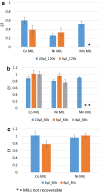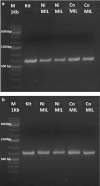Development of an innovative and sustainable one-step method for rapid plant DNA isolation for targeted PCR using magnetic ionic liquids
- PMID: 30899320
- PMCID: PMC6408755
- DOI: 10.1186/s13007-019-0408-x
Development of an innovative and sustainable one-step method for rapid plant DNA isolation for targeted PCR using magnetic ionic liquids
Abstract
Background: Nowadays, there is an increasing demand for fast and reliable plant biomolecular analyses. Conventional methods for the isolation of nucleic acids are time-consuming and require multiple and often non-automatable steps to remove cellular interferences, with consequence that sample preparation is the major bottleneck in the bioanalytical workflow. New opportunities have been created by the use of magnetic ionic liquids (MILs) thanks to their affinity for nucleic acids.
Results: In the present study, a MIL-based magnet-assisted dispersive liquid-liquid microextraction (maDLLME) method was optimized for the extraction of genomic DNA from Arabidopsis thaliana (L.) Heynh leaves. MILs containing different metal centers were tested and the extraction method was optimized in terms of MIL volume and extraction time for purified DNA and crude lysates. The proposed approach yielded good extraction efficiency and is compatible with both quantitative analysis through fluorimetric-based detection and qualitative analysis as PCR amplification of multi and single locus genes. The protocol was successfully applied to a set of plant species and tissues.
Conclusions: The developed MIL-based maDLLME approach exhibits good enrichment of nucleic acids for extraction of template suitable for targeted PCR; it is very fast, sustainable and potentially automatable thereby representing a powerful tool for screening plants rapidly using DNA-based methods.
Keywords: Arabidopsis thaliana (L.) Heynh.; DNA barcoding; DNA isolation; Magnetic ionic liquids.
Figures







Similar articles
-
Versatile DNA extraction from diverse plant taxa using ionic liquids and magnetic ionic liquids: a methodological breakthrough for enhanced sample utility.Plant Methods. 2024 Jun 14;20(1):91. doi: 10.1186/s13007-024-01217-z. Plant Methods. 2024. PMID: 38877523 Free PMC article.
-
Extraction of DNA with magnetic ionic liquids using in situ dispersive liquid-liquid microextraction.Anal Bioanal Chem. 2019 Nov;411(28):7375-7385. doi: 10.1007/s00216-019-02163-9. Epub 2019 Oct 26. Anal Bioanal Chem. 2019. PMID: 31655857
-
Isolation of DNA from plant tissues using a miniaturized matrix solid-phase dispersion approach featuring ionic liquid and magnetic ionic liquid solvents.Anal Chim Acta. 2023 Mar 8;1245:340858. doi: 10.1016/j.aca.2023.340858. Epub 2023 Jan 19. Anal Chim Acta. 2023. PMID: 36737141
-
Green aspects, developments and perspectives of liquid phase microextraction techniques.Talanta. 2014 Feb;119:34-45. doi: 10.1016/j.talanta.2013.10.050. Epub 2013 Oct 29. Talanta. 2014. PMID: 24401382 Review.
-
Magnetic ionic liquids in analytical chemistry: A review.Anal Chim Acta. 2016 Aug 31;934:9-21. doi: 10.1016/j.aca.2016.06.011. Epub 2016 Jun 13. Anal Chim Acta. 2016. PMID: 27506339 Review.
Cited by
-
Comparing DNA isolation methods for forest trees: quality, plastic footprint, and time-efficiency.Plant Methods. 2023 Oct 19;19(1):111. doi: 10.1186/s13007-023-01086-y. Plant Methods. 2023. PMID: 37858169 Free PMC article.
-
Versatile DNA extraction from diverse plant taxa using ionic liquids and magnetic ionic liquids: a methodological breakthrough for enhanced sample utility.Plant Methods. 2024 Jun 14;20(1):91. doi: 10.1186/s13007-024-01217-z. Plant Methods. 2024. PMID: 38877523 Free PMC article.
-
Simple and efficient isolation of plant genomic DNA using magnetic ionic liquids.Plant Methods. 2022 Mar 24;18(1):37. doi: 10.1186/s13007-022-00860-8. Plant Methods. 2022. PMID: 35321738 Free PMC article.
-
Guidelines for the effective and ethical sampling of herbaria.Nat Ecol Evol. 2025 Feb;9(2):196-203. doi: 10.1038/s41559-024-02544-z. Epub 2024 Sep 27. Nat Ecol Evol. 2025. PMID: 39333397 Review.
-
The Potential Use of Isothermal Amplification Assays for In-Field Diagnostics of Plant Pathogens.Plants (Basel). 2021 Nov 10;10(11):2424. doi: 10.3390/plants10112424. Plants (Basel). 2021. PMID: 34834787 Free PMC article. Review.
References
-
- Galimberti A, De Mattia F, Losa A, Bruni I, Federici S, Casiraghi M, et al. DNA barcoding as a new tool for food traceability. Food Res Int. 2013;50(1):55–63. doi: 10.1016/j.foodres.2012.09.036. - DOI
-
- Marengo A, Piras A, Falconieri D, Porcedda S, Caboni P, Cortis P, et al. Chemical and biomolecular analyses to discriminate three taxa of Pistacia genus from Sardinia Island (Italy) and their antifungal activity. Nat Prod Res. 2018;32(23):2766–2774. - PubMed
LinkOut - more resources
Full Text Sources

